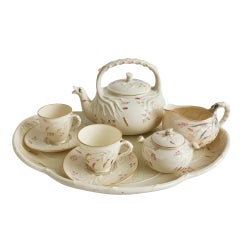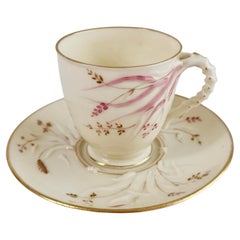Belleek Grass Pattern
Antique Late 19th Century Northern Irish Victorian Tea Sets
Porcelain
Recent Sales
Antique Late 19th Century Northern Irish Arts and Crafts Tea Sets
Porcelain
People Also Browsed
Antique Late 19th Century English Victorian Sports Equipment and Memorab...
Sterling Silver
Vintage 1910s British Books
Paper
Vintage 1920s English Art Deco Bedroom Sets
Chrome
Vintage 1920s French Art Deco Vases
Blown Glass
Antique 1890s English Art Nouveau Glass
Crystal
Antique 19th Century French Stone Sinks
Carrara Marble
Antique Late 19th Century German Collectible Jewelry
Vermeil, Silver
Antique 15th Century and Earlier German Decorative Art
Other
Antique 1840s American Collectible Jewelry
Quartz, Metal, Gold
Antique Early 19th Century English George III Bookcases
Mahogany
20th Century Books
Paper
Antique 15th Century and Earlier European French Provincial Books
Leather
Antique Late 19th Century Italian Grand Tour Snuff Boxes and Tobacco Boxes
Stone, Silver
Antique 19th Century German Models and Miniatures
Silver
Antique Late 19th Century Russian Decorative Art
Silver
Early 20th Century English Decorative Boxes
Brass
Finding the Right Porcelain for You
Today you’re likely to bring out your antique and vintage porcelain in order to dress up your dining table for a special meal.
Porcelain, a durable and nonporous kind of pottery made from clay and stone, was first made in China and spread across the world owing to the trade routes to the Far East established by Dutch and Portuguese merchants. Given its origin, English speakers called porcelain “fine china,” an expression you still might hear today. "Fine" indeed — for over a thousand years, it has been a highly sought-after material.
Meissen Porcelain, one of the first factories to create real porcelain outside Asia, popularized figurine centerpieces during the 18th century in Germany, while works by Capodimonte, a porcelain factory in Italy, are synonymous with flowers and notoriously hard to come by. Modern porcelain houses such as Maison Fragile of Limoges, France — long a hub of private porcelain manufacturing — keep the city’s long tradition alive while collaborating with venturesome contemporary artists such as illustrator Jean-Michel Tixier.
Porcelain is not totally clumsy-guest-proof, but it is surprisingly durable and easy to clean. Its low permeability and hardness have rendered porcelain wares a staple in kitchens and dining rooms as well as a common material for bathroom sinks and dental veneers. While it is tempting to store your porcelain behind closed glass cabinet doors and reserve it only for display, your porcelain dinner plates and serving platters can safely weather the “dangers” of the dining room and be used during meals.
Add different textures and colors to your table with dinner plates and pitchers of ceramic and silver or a porcelain lidded tureen, a serving dish with side handles that is often used for soups. Although porcelain and ceramic are both made in a kiln, porcelain is made with more refined clay and is stronger than ceramic because it is denser.
On 1stDibs, browse an expansive collection of antique and vintage porcelain made in a variety of styles, including Regency, Scandinavian modern and other examples produced during the mid-century era, plus Rococo, which found its inspiration in nature and saw potters crafting animal figurines and integrating organic motifs such as floral patterns in their work.
- How can you tell Belleek?1 Answer1stDibs ExpertOctober 24, 2024To tell Belleek, look for a maker's marking. Usually, the Irish maker has placed its marks on the bottom of its pieces. Over the course of the company's long history, Belleek has changed its stamps many times. As a result, you can often identify and date a Belleek piece by comparing the color, wording and logo graphic to images shared on trusted online resources. Once you roughly know how old your item is, you can then search online catalogues to determine the style name and learn more about your piece. If you need any help while carrying out the identification process, a certified appraiser or experienced dealer can assist you. Explore a collection of Belleek pottery on 1stDibs.

